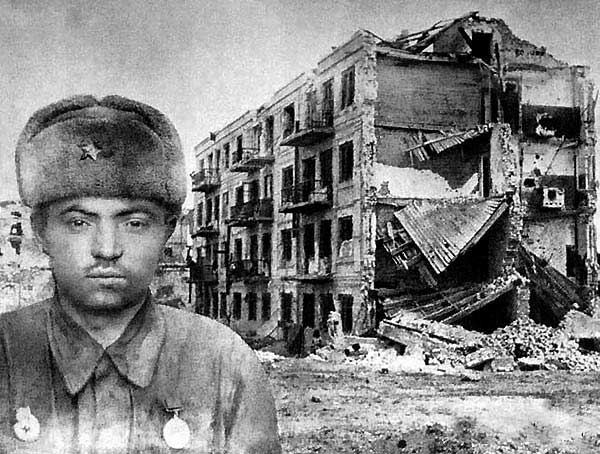Pavlov's House

Pavlov's House became the name of a fortified
apartment building during the Battle of Stalingrad from 27
September, 1942 to February 2, 1943. It gained its popular name from
Sergeant Yakov Pavlov, who commanded the platoon that seized the
building and defended it during the long battle.
The house was a four-story building in the center
of Stalingrad, built parallel to the embankment of the river Volga
and overseeing the "9th January Square", a large square named for
Bloody Sunday. In September 1942, the house was attacked by German
soldiers, and a platoon of the Soviet 13th Guards Rifle Division was
ordered to seize and defend it. The platoon was led by Junior Sgt.
Yakov Pavlov, a low-level noncommissioned officer serving as acting
platoon commander since the unit's lieutenant and senior sergeants
had all been wounded or killed. The attack on the building was
successful, although the fighting was brutal, with only four men in
the 30-man platoon surviving the assault.
The strategic benefit of the house was its position on a
cross-street giving the defenders a 1 km line of sight to the north,
south and west. After several days, reinforcements and resupply
arrived for Pavlov's men, bringing the unit up to a 25-man
understrength platoon and equipping the defenders with machine guns,
anti-tank rifles, and mortars. In keeping with Stalin's Order No.
227 - "not one step back", Sgt. Pavlov was ordered to fortify the
building and defend it to the last bullet and the last man. Taking
this advice to heart, Pavlov ordered the building to be surrounded
with four layers of barbed wire and minefields, and set up
machine-gun posts in every available window facing the square. In
the early stages of the defense, Pavlov discovered that a PTRS-41
anti-tank rifle he had mounted on the roof was particularly
effective when used to ambush unsuspecting German tanks; once the
tanks had approached to within 25 meters of the building, their thin
turret-roof armor became exposed to AT rifle fire from above, but
they were unable to elevate their weapons enough to retaliate.
Pavlov had reportedly destroyed nearly a dozen tanks personally
using this tactic.
For better internal communication, they breached the walls in the
basement and upper floors, and dug a communications trench to Soviet
positions outside. Supplies were brought in via the trench or by
boats crossing the river, defying German air raids and shelling.
Nevertheless, food and especially water was in short supply. Lacking
beds, the soldiers tried to sleep on insulation wool torn off pipes,
yet usually the Germans kept shooting at the house with deafening
machine-gun fire day and night.
The Germans attacked the building at regular times. Each time German
infantry or tanks tried to cross the square and to close in on the
house, Pavlov's men laid down a withering barrage of machine gun and
AT rifle fire from the basement, the windows and from the roof top,
devastating the German attackers and forcing them to retreat. By
mid-November, Pavlov's men reportedly had to use lulls in the
fighting to run out and kick over the heaped piles of German corpses
so they could not be used as cover for the next round of attackers.[dubious
– discuss]
Eventually the defenders, as well as the Soviet civilians who kept
living in the basement all that time, held out during intensive
fighting from 23 September until 25 November 1942, when they were
relieved by the counter-attacking Soviet forces.
Pavlov's House became a symbol of the stubborn
resistance of the Soviet Union in the Battle of Stalingrad, and in
the Great Patriotic War in general. It stands out prominently
because the German armies had previously conquered cities and entire
countries within weeks; yet they were unable to capture a single
half-ruined house, defended most of the time by just over a dozen
soldiers, in spite of trying for two months. It is reported that the
building at the "9th January Square" was marked as a fortress in
German maps.
Vasily Chuikov, commanding general of the Soviet forces in
Stalingrad, later bragged that the Germans lost more men trying to
take Pavlov's house than they did taking Paris.
Pavlov's "House" was rebuilt after the battle and is still used as
an apartment building today. There is an attached memorial
constructed from bricks picked up after the battle on the East side
facing the Volga.

Pavlov was awarded the title Hero of the Soviet Union for his
actions.
Pavlov was born 1917, drafted into
Red Army 1938 (artillery?). The next we know he is part of Rodimtsev's 13th. Guards in
Stalingrad. Badly wounded in the defence of "his" house he was hospitalised for a time. Made
lieutenant in 1944, re-joined 13th. (now 8th.) Guards. Made senior lieutenant &
participated in taking of Berlin. Komsomol member, KPSS member in 1944, Hero of Soviet Union
in 1945.
Yacob Pavlov later became the Archimantdrite Kyrill in the monastary
at Sergievo, formerly Zagorsk, where he attracked a huge following of the faithfull
that had nothing to do with his fame from Stalingrad.
He died 1981.
Map and list of the
defenders of Pavlov's House who participated in it's defense from 26
September 1942 till 25 November 1942.
Map of the house and a list
of the defenders of Pavlov's House.
.
|